[Might Have Been tracks the failures of promising games, characters, and companies. This installment looks at World Beach Volley, released for the Game Boy in 1991.]
Cute sports games often go unappreciated. Most sports titles may strive for realistic takes on baseball, soccer, football, ice hockey, curling, field hockey, bowling, water hockey, snooker, cricket, dino hockey, and every other type of pastime, but credit must go to the developers who went the opposite direction and turned a popular sport into a simplified cavalcade of big-headed characters and approachable gameplay. It’s still a viable field today, but it was especially prolific on the Game Boy, where basic hardware inspired—or perhaps demanded—more abstract appearances. That’s where you’ll find Graphic Research’s World Beach Volley.
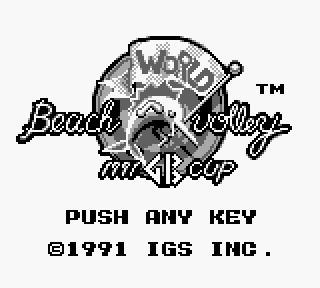
Straightforward in its presentation, World Beach Volley offers a player two-on-two matches with adjustable rules about points and court-swapping. Controls are handled well with two buttons for serving, spiking, and blocking. It’s all similar to Technos Japan’s excellent Super Spike V’Ball, though perhaps not as aggressive with its fierce spikes.
Two players can take part via a link cable, but it’s not so bad to be stuck with computer-controlled opponents and partners. The AI actually proves helpful here, as it can spike and block instead of just setting up your character for a move. This also results in your teammate getting in your way at times, but that's the price of an independent thinker.
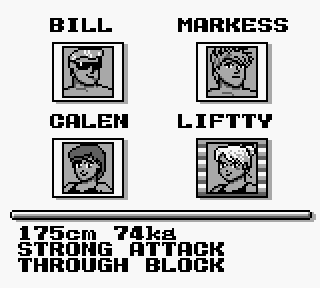
Shunning any real-world rules about gender-based leagues, World Beach Volley offers an international tournament where men and women compete side by side. You’re given a spread of six countries with four players apiece, complete with delightful names and specialties. What’s more American than a blonde spiker named Liftty and her “strong attack through block” or the “Big Fighter” Bill? Or perhaps you’d prefer the Russian player named Rossyan or Lie and her “Chinese Hope,” whatever that means?
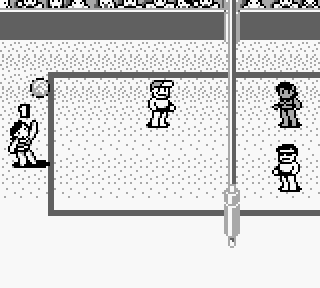
It’s an amusing lineup, and Graphic Research cared enough to animate each player’s portrait when their team scores. True, there’s only so much that the gameplay itself can embody. Apart from skin color, most of the characters look similar. The women vary mostly in hairstyles, while the male players have a little more diversity: some of them look like Steve Dallas from Bloom County, and some of them look like the main character from that Treasure Master NES game no one cared about after its in-game contest expired. I can’t be the only one who sees that.
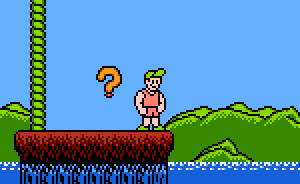
Even with its limited appearances,
World Beach Volley is charming. The game moves quickly, and the shifting viewpoint never leaves you confused about where everyone is. The music is bouncy and fun, and the developers even added a voice for the referee. She might not have the timeless appeal of
Sandra Court, but it’s a memorable touch for a Game Boy outing. In fact, her voice is same as the one heard in the
Battle Mania/
Trouble Shooter games—no coincidence, since Graphic Research handled the sound for that series and even credited the same actress, Yukichan. You just knew I’d work
Trouble Shooter into this, didn’t you?
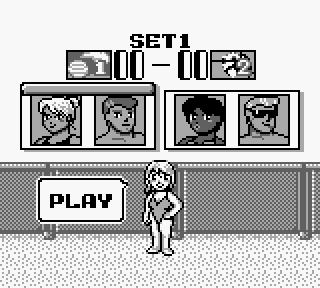
World Beach Volley remains enjoyable, though it’s unambitious in the long run. The multiplayer angle was perhaps its major hook, and the solo mode has no accoutrements that we’d expect of modern games. No RPG-like player progression. No branching choices about which opponents to face next. No bonus modes where you romance your team coach. That’s more of an SNK thing, anyway.
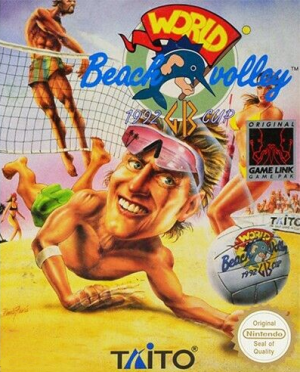
An international release seemed likely for World Beach Volley, as much of its text is already in English. Publisher IGS gave it a generic stock photo of live volleyball for its Japanese box art, but Taito went with a more extreme cover, one where a leering, contorted mutant player looks more like he's trying to sell a new flavor of Gushers than a Game Boy game.
Perhaps this was too grotesque for American sensibilities, as Taito only published World Beach Volley in Europe. It was an unfortunate blow to any U.S. Game Boy owner who wanted a portable equivalent of Super Spike V’Ball and weren’t satisfied with Malibu Beach Volleyball’s odd perspective and dubious Tose programming.
World Beach Volley stood alone, leaving the sand-court exploits of Liftty and Markess without follow-ups. Had Graphic Research pushed the ideas a little further in a sequel, perhaps into four-player territory, it could’ve grown into a series. And today we’d be enjoying the carefree flow of the latest World Beach Volley’s league mode instead of looking for cartoonish volleyball fun in some tepidly risque Dead or Alive afterthought.
Volleyball games and the industry at large have perhaps rendered World Beach Volley irrelevant, but there’s still some allure to it. It’s a memento of an ‘80s anime aesthetic and the compelling simplicity of early Game Boy offerings. You were fun back in 1991, World Beach Volley, and you know what? You still are.







No comments:
Post a Comment